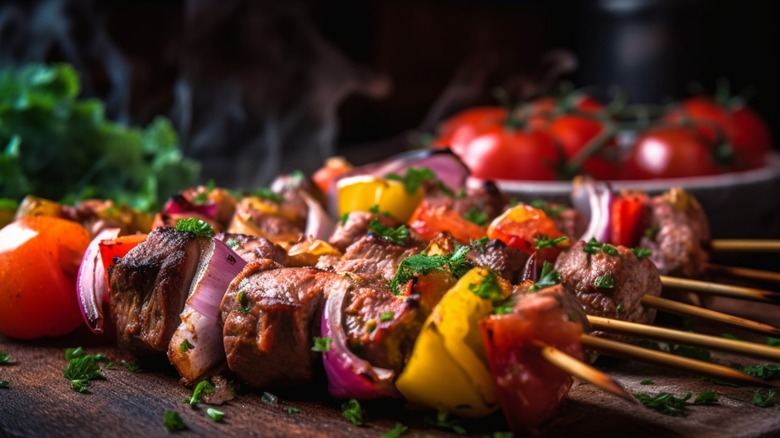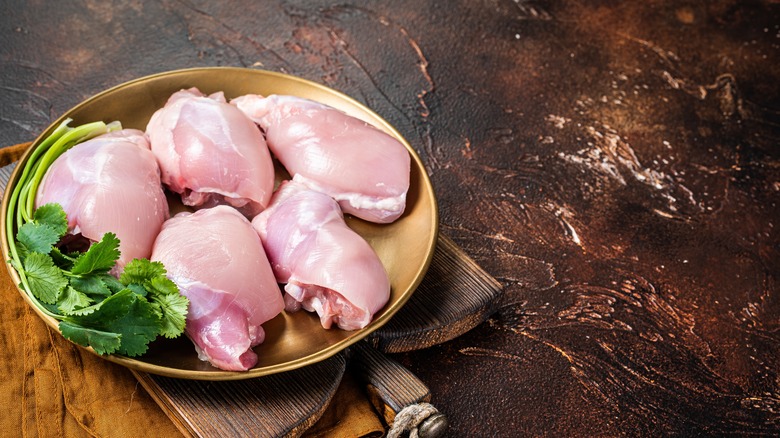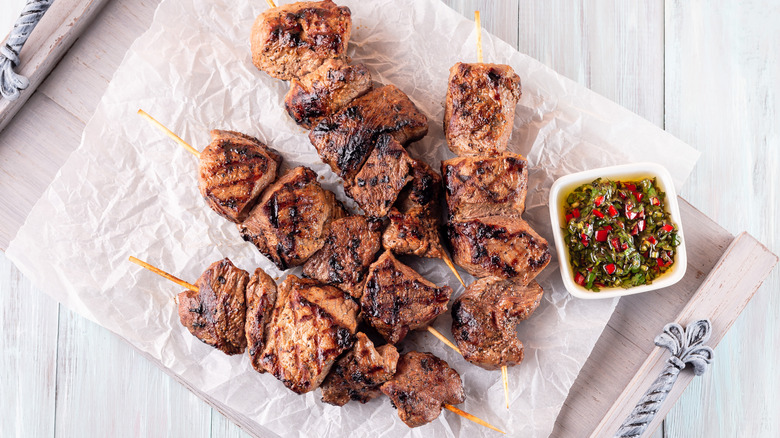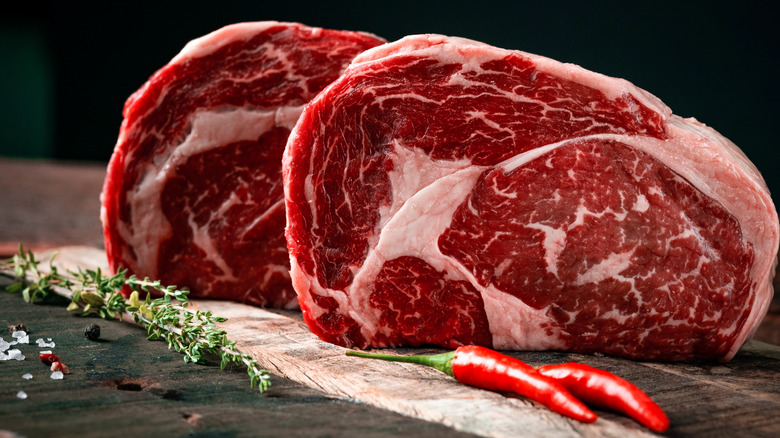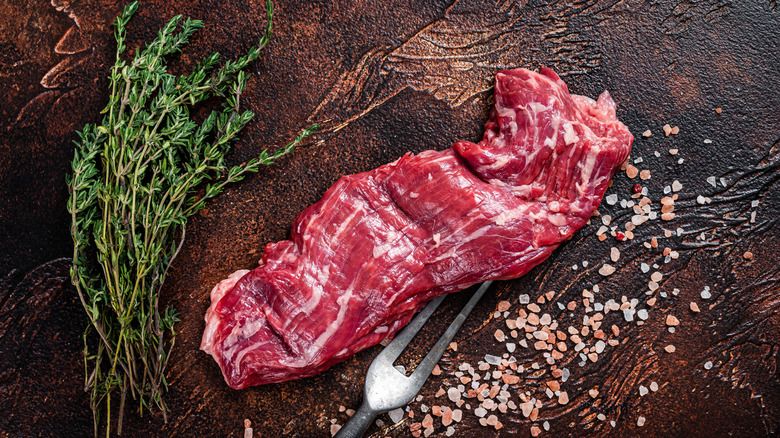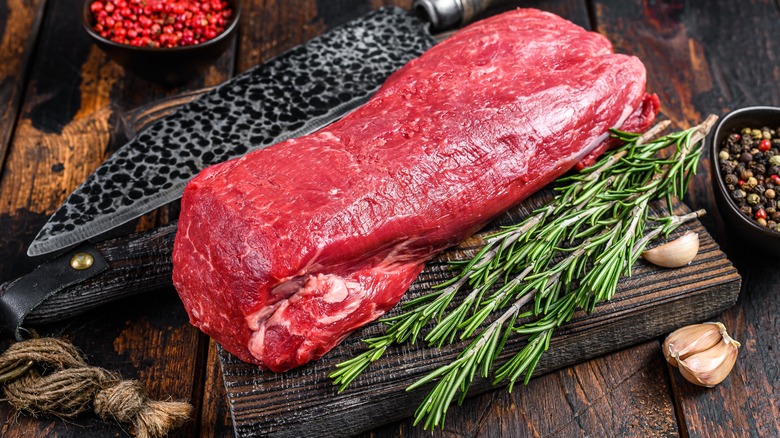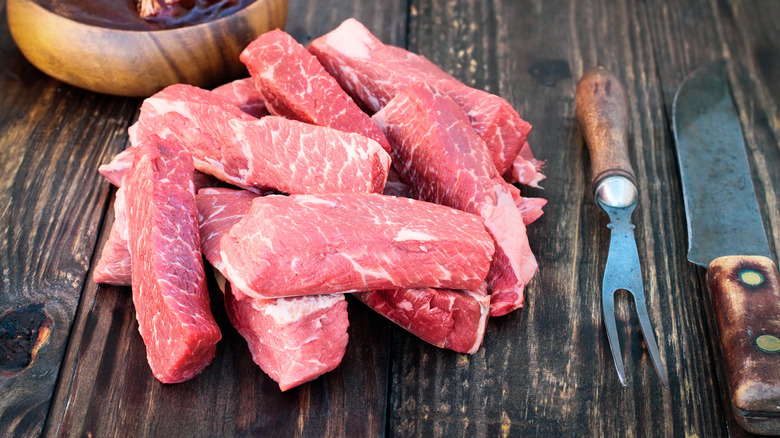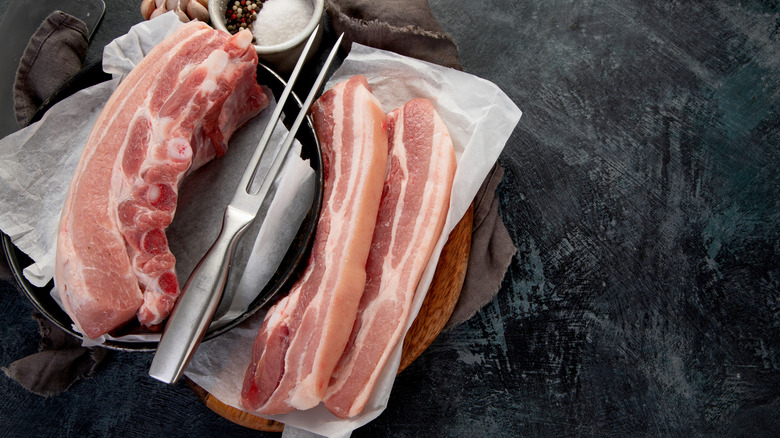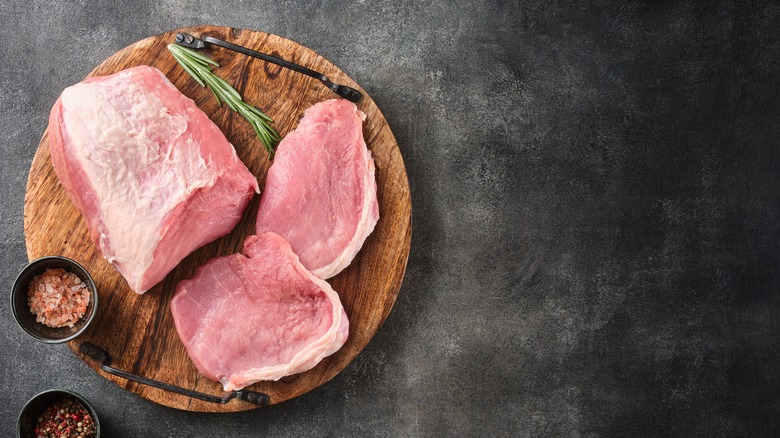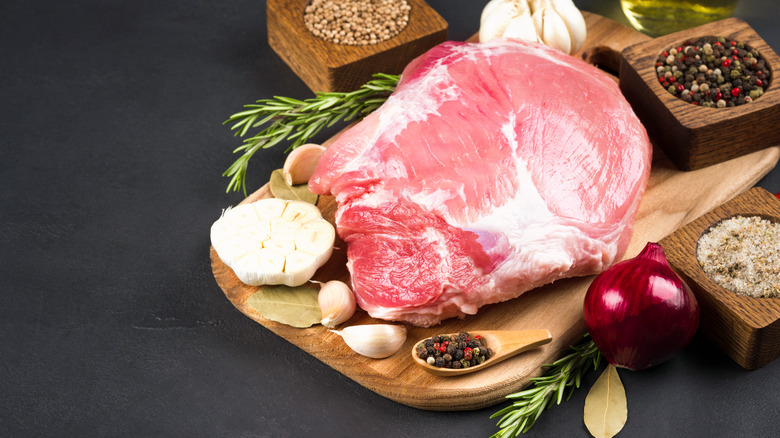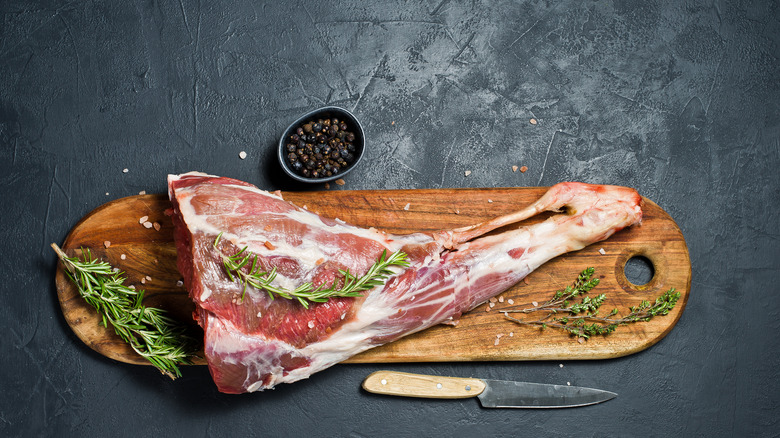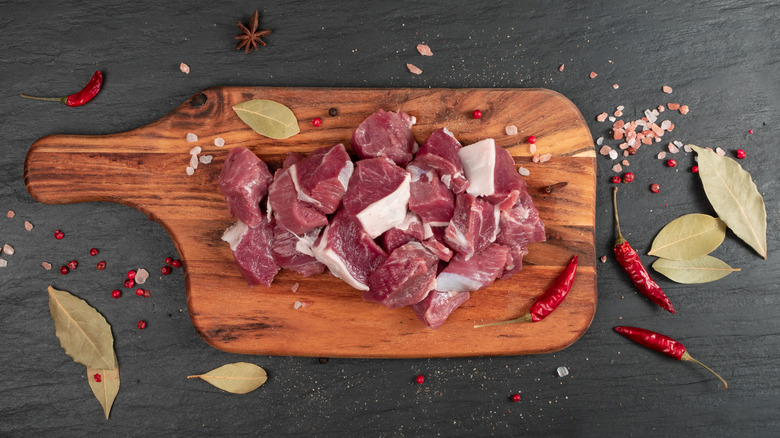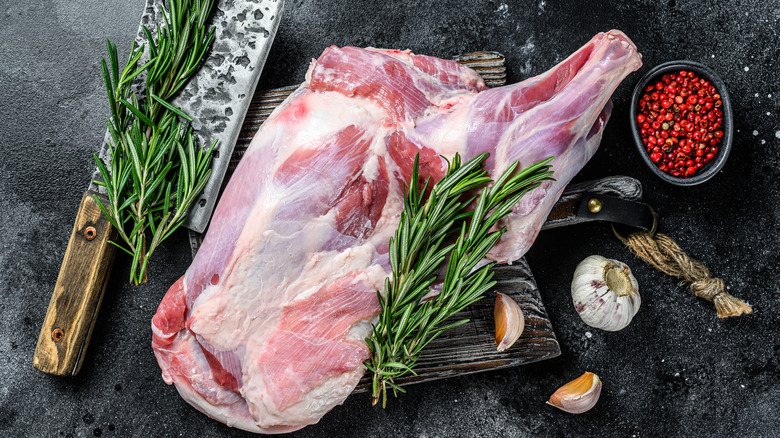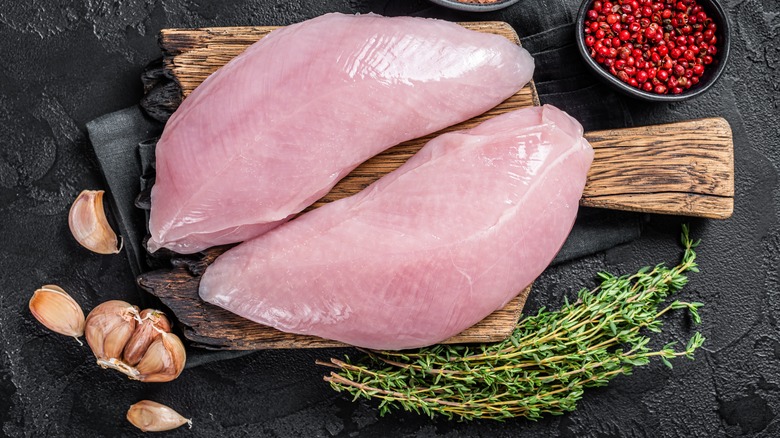13 Best Cuts Of Meat For Grilled Kebabs
Fall is for football and that means hordes of hungry fans looking to fill their anxious bellies with something more satisfying than just chips and salsa. The best tailgates feature flame-grilled fare and no dish answers the call quite like a kebab. Versatile, flavorful, and easy to eat wherever the game might take you, grilled skewers packed with meat and veg score big any time of year.
While almost anything goes when it comes to building a kebab, picking the perfect protein is paramount. Grilled kebabs call for meaty cuts with just the right amount of fat to keep the morsel tender, but not so juicy that they slide right off the skewer. Second to protein procurement is proportion. One of the top tips for building extra juicy kebabs is to choose similarly sized ingredients to avoid uneven cooking. Another hot tip? Never use dry wooden skewers on a grill. If you're going the wooden stick route, be sure to soak those skewers for at least 30 minutes before throwing them on an open flame to avoid a major tailgate faux pas.
Ready to fire up the grill? Grab your skewers and your seasonings, and add these cuts of beef, poultry, and pork to your game-day lineup to ensure a winning bite.
Chicken thighs
Tried-and-true chicken skewers tend to be a crowd favorite — when cooked correctly, that is. For some added flavor insurance, skip the chicken breast and cook with boneless, skinless thighs instead. Boasting a higher fat content, chicken thighs can stand up to a hot grill without becoming tough. The fact that they tend to be cheaper than chicken breasts is just an added bonus.
For the absolute best-grilled chicken kebabs, marinate your meat for a few hours prior to cooking. When it comes to marinades, any combination of acid, oil, and seasoning will do, so feel free to get creative with your flavors. Use Greek yogurt, lemon, and oregano for a Mediterranean twist or buttermilk, pickle juice, and paprika for a Southern spin. No matter the lineup, the game plan for marinade success is roughly one part acid to three parts fat or oil.
Once your thighs are nicely marinated, be sure to cut them into equally sized chunks to guarantee even cooking. Layer with vegetables like zucchini and bell peppers — keeping proper proportions in mind — for a colorful and nutritious way to round out your gourmet grilling game. A final sprinkle of salt and pepper guarantees a flavorful final result.
Sirloin tips
When it comes to beefy kebabs, sirloin tips provide the best bang for your buck. Also sometimes confusingly labeled as "steak tips," these meaty cubes of beef are lean enough to hold their shape when skewered with just the right ratio of fat to render the final product juicy and delicious after a quick sear on the grill.
A lack of fat does mean that sirloin tips require a little extra love before they're ready to anchor a mouthwatering skewer. The best way to avoid drying out the meaty morsels is to soak them in a tenderizing steak marinade. The acid in the mixture will help to break down those tough proteins, resulting in a much more satisfying, melt-in-your-mouth bite.
Another way to keep the beef from drying out is to employ a meat thermometer. You'll want to aim for an internal temperature of 145 degrees F to achieve a food-safe medium, according to the USDA, though some may prefer their beef a bit on the rarer side. No matter how you choose to prepare your kebabs, be sure to let the meat rest for a few minutes after grilling to allow the muscle fibers to relax and the juices to redistribute. It may be tempting to dig in immediately but trust that your patience will be rewarded with a tender and juicy skewer.
Ribeye
If your budget is a little beefier, reach for boneless ribeye steaks when building your next batch of kebabs. Thanks to higher fat content, the pricer cut doesn't require a marinade to keep it tender and also promises a juicy result even if you take your eye off the grill for a minute too long.
When selecting your specimen, look for a steak with plenty of light-colored lines snaking their way through the meat — this is called marbling and those pale lines are inter-muscular fat revealing a roadmap to beefy goodness. Thanks to this well-dispersed layer of fat, overcooking a ribeye rarely ruins it, which also makes it an ideal cut for those new to the world of kebab cooking. In fact, the only prep needed is to cube the beef into equally sized chunks and season it generously with salt and pepper.
Share the wealth by stuffing your skewers with plenty of vegetables between bites of beef. Opt for heartier produce like eggplant or squash and if you choose to add onion, keep it in larger chunks to avoid it burning before the beef is cooked through.
Skirt steak
For a textural twist on beef-packed skewers, go for versatile skirt steak. Thin and richly marbled, the quick-cooking meat is a flavorful protein option for kebabs that are table-ready in just minutes.
Thanks to its signature thinness, skirt steak can be cooked quickly over high heat without being rendered dry and tasteless. While the cut isn't tough, it can certainly be chewy. The long, thin cut of beef is sourced from the cow's abdomen, an active area on the animal filled with plenty of muscle fiber, sinew, and connective tissue. A long soak in an acidic marinade helps to break down those more gnarly bits while an extra layer of fat helps to keep the meat naturally tender, a winning combination that ensures your skirt steak won't turn out chewy.
After marinating, cut the steak against the grain into extra-thin slices and fold them over a few times before skewering to ensure even cooking and a tender final product. Unlike thicker ribeye, skirt steak is not as forgiving if overcooked, so be sure to keep an eye on your kebabs and sear them for just a few minutes per side. For an extra flavorful flair, serve your skirt steak skewers with a mouthwatering dipping sauce like chimichurri.
Beef tenderloin
Kebabs are not traditionally a vehicle for showcasing prime cuts of beef but if you've got the budget for it, beef tenderloin can't be beaten. Sourced from the cow's short loin (a subprimal along the back and behind the ribs), the popular cut of steak benefits from its location along a relaxed and rarely used set of muscles, resulting in a super-lean yet delightfully tender bite.
Thanks to its tender disposition and super-fine marbling, beef tenderloin needs only a generous sprinkling of salt and pepper before hitting the grill. However, that juicy goodness can quickly turn dry and tough if you don't keep a careful eye on your skewers — filet only needs a few minutes per side over an open flame. For a little extra insurance (and a boost of flavor), try wrapping your beef in bacon to insulate the meat with some much-needed fat during the cooking process.
To match the quality of the beef, add elevated ingredients to your kebabs like portobello mushrooms, heirloom tomatoes, whole small potatoes, or even whole garlic cloves. Drizzle the final product with quality balsamic vinegar for a gourmet game-day treat.
Boneless beef short ribs
A lesser-known cut that deserves pride of place at your next tailgate is the humble boneless short rib. Cheaper than traditional steaks and richly flavored, boneless beef short ribs are a great choice for beginner cooks thanks to their high-fat content — in other words, they're forgiving when overcooked. As its name suggests, the versatile cut comes pre-boned so all you have to do is chop the meat into skewer-ready chunks.
So if this cut is so great, why don't more people use it? Likely, it's just a lack of kitchen know-how. Since boneless beef short ribs aren't technically a steak, many cooks just don't know what to do with them. Cut from the shoulder of the steer (aka, the "chuck"), the versatile cut can be braised, smoked, seared, or cooked up pretty much however you choose.
Plenty of rich marbling and a lack of connective tissue make these boneless beauties a perfect choice for a hot grill without much prep. Just blot the beef dry with a paper towel to ensure even browning and season with salt and pepper or a dry rub, if preferred. Cook up short rib kebabs to serve alongside a refreshing salad or skewer with an array of colorful vegetables for a one-stop meal on a stick.
Pork belly
There are few vegetables that couldn't be improved with a dose of succulent, savory pork belly. Rich and fatty, pork belly is packed with plenty of flavor which is made even more enticing with the addition of smoke — in short, it's one of the absolute best cuts of pork to grill.
The cheaper cut is a prime choice to feed a crowd, especially when skewered with a colorful array of fresh veggies. Essentially one large muscle with a thick fat cap, pork belly is traditionally cooked low and slow to render the fat and transform the meat into a melt-in-your-mouth delicacy. However, by employing a few simple pork-cooking tips, the same result can be achieved with flame-grilled kebabs.
As with any other kebab, you'll want to chop up the porky cut into cubes before employing a mouthwatering marinade. Thanks to its natural richness, pork belly can stand up to strong flavors like barbecue sauce, soy sauce, miso, hot sauce, vinegar, or any tantalizing taste combination you can think of. As long as your mixture includes the right ratio of acid to fat, the pork belly will be primed for the grill, cooking up perfectly in just a few minutes. As an added bonus, all that fatty flavor will drip onto the surrounding veggies, transforming even the most avid produce-avoider into a vegetable kebab fan.
Pork loin
Lean, mean pork loin is a blank culinary canvas just waiting for you to unleash your kebab creativity. Found at almost every butcher counter across the country, pork loin's popularity comes from its accessibility, affordability, and supreme versatility, meaning most home cooks likely aren't letting the classic cut shine as the MVP it was meant to be.
Like its beef counterpart, the pork loin is sourced from the loin muscle that runs along the pig's back from its shoulder to its haunches. A lesser-used muscle, the cut is both tender and lean with a thin fat cap that helps the meat stay moist during the cooking process. While not quite as delicate as the tenderloin, the pork loin is significantly cheaper and a better option for feeding hordes of hungry sports fans.
Thanks to its naturally mild profile, pork loin will soak up almost any seasoning you throw at it. But getting the most flavor out of this lean cut takes a little patience. While wet brining or marinating is a great way to imbue the meat with extra moisture, the smaller loin requires a bit more vigilance to ensure the flavor is evenly distributed and that the protein doesn't break down too much. A flavorful alternative is to employ a dry rub. Mix up your preferred combination of seasonings and massage evenly into the meat, letting it rest for a few hours or even overnight before cubing, skewering, and tossing on the grill.
Pork shoulder
Thanks to an extra layer of fat, cubed pork shoulder produces a tender and juicy kebab, especially when paired with fresh fruit like pineapple for a smoky, sweet taste sensation that transports you to tropical shores. If you do choose to go the fruit route for your next batch of kebabs, be sure to wrap the delicate produce in aluminum foil to prevent it from sliding off the skewers and into grill purgatory.
When you head to the butcher counter, look for a pork or picnic shoulder, not a pork butt. Both are butchered from the pig's shoulder primal but while the latter is the preferred cut for smoking thanks to its rich marbling, the shoulder sub-primal is leaner and boasts the benefit of a thin layer of skin that crisps up nicely when cooked. It does typically come on the bone, but you can ask your butcher to cube the meat for you to save some precious kebab time.
While a sprinkling of salt and pepper would be fine, opt to get creative with your flavors. A prime cut to use for Chinese comfort food char siu, pork shoulder benefits from a combination of sweet and savory sauces that highlight the richness of the meat. To make this Cantonese classic, marinate your cubed pork shoulder in a blend of hoisin and soy sauce before skewering and searing. For an authentic touch, glaze the final product with maltose to achieve that signature shiny coat and serve with rice.
Leg of lamb
One of the best cuts of lamb to grill, leg of lamb has been a staple of the Mediterranean diet for thousands of years — there are even references to flame-cooked lamb recipes in Homer's 3,000-year-old epic poem "The Iliad." While the large cut is typically slow-roasted and served whole as a centerpiece for holiday meals, it also works wonders when cubed, skewered, and cooked quickly over an open flame.
Give your next batch of kebabs a Greek twist with a spiced honey mint marinade. Soak 1- to 1 ½-inch cubes of boneless lamb leg (simply ask your butcher to cube the leg of lamb for you) in a tangy blend of fresh mint, honey, lemon juice, garlic, ground cumin, chili flakes, and olive oil. Cubing the meat prior to marinating helps it soak up more flavor in less time than a whole leg of lamb — in this case, just 15 to 30 minutes will work wonders.
Skewer the marinated meat and grill until the interior is slightly pink and the internal temperature has reached at least 145 degrees F, about six to eight minutes. Let the kebabs rest briefly before serving to a grateful crowd.
Lamb sirloin
Well-marbled yet lean lamb sirloin holds its shape beautifully when skewered and still produces a deliciously juicy kebab. A smaller cut of lamb sourced from the larger leg primal, the sirloin is most often sold as steaks, chops, or even a whole roast. It can be a bit pricier than other proteins but its flavor is worth the splurge for a sensationally savory skewer.
Similar to a beef sirloin steak, the lamb version is delicious on its own with just a sprinkle of salt and pepper. Nicely charred over an open flame, the meat is tender and flavorful when cooked to an enticing medium-rare, which thanks to the cut's small size doesn't take too long. Just remember that the key to perfectly pink lamb skewers is a bit of downtime. Let the kebabs rest for a few minutes after cooking so that they retain all that juicy goodness.
To cut through the richness of the meat, try serving your lamb sirloin kebabs with a refreshing sauce like herby salsa verde or tangy tzatziki. Pair the final product with fluffy pita or roasted potatoes and you've got a winning combination for your next game-day feast.
Lamb shoulder
Sourced from one of the hardest working parts of the animal, lamb shoulder is typically reserved for slow-roasting applications due to a surplus of tough muscle fibers and tendons that require low and slow heat to break down properly. But the beauty of the kebab is that smaller chunks of tough cuts cooked quickly over an open flame tend to turn out just as delicious as their braised counterparts.
Thanks to its tough reputation, lamb shoulder tends to be cheaper than other cuts of the animal, making it an ideal kebab candidate when given a little extra attention. Trimming off the excess fat helps keep the muscle-to-fat ratio in ideal proportion for grilling, while a soak in a tendering, acid-rich marinade keeps things moist.
One of the biggest mistakes to avoid with lamb is overcooking. The other red meat is at its prime when cooked to a soft pink medium rare. Any longer, and you run the risk of your meal turning chewy and tough. A tip to avoid a dreaded, dry fate is to pull the kebabs off the grill just before they're done and let the meat continue to cook as it rests.
Turkey breast
While experienced cooks may tout the virtues of dark meat poultry, the most popular cut of turkey is still hands down the breast. But the fan-favorite cut shouldn't just be reserved for the Thanksgiving table. The mild-flavored bird can handle a wide array of seasonings, making it an ideal substitute for red meat or pork in savory flame-grilled kebabs.
As with any other type of dry-heat cooking method, retaining moisture is key to ensuring a delicious final product. When it comes to turkey, prep as you would for Thanksgiving dinner — with a brine. Since kebabs typically feature smaller cubes of meat, you won't need to soak the bird overnight but a few hours in a briny mixture of saltwater and aromatics will certainly help your turkey stay moist.
Impart both fat and flavor into the bird with a quick toss in a well-seasoned marinade before skewering with plenty of fresh vegetables. Keep a careful eye on your turkey kebabs while grilling to avoid the annual Thanksgiving travesty of overcooked meat. When it comes to poultry, it's best to employ a meat thermometer to ensure the internal temperature reaches a food-safe 165 degrees F.
